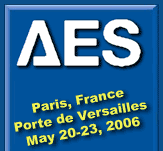

Home | Technical Program | Exhibition | Visitors | Students | Press
Last Updated: 20060403, mei
P13 - Audio Archiving, Storage, Restoration, and Content ManagementSunday, May 21, 16:00 — 17:40
Chair: Antonio Oliart, WGBH Educational Foundation - Boston, MA, USA
P13-1 Advanced Cataloging and Search Techniques in Audio Archiving—Helge Blohmer, VCS Aktiengesellschaft - Bochum, Germany
Ever since the processing capabilities of computers reached the point where audio indexing and searching became possible using techniques beyond simple, manually entered textual annotation in the late 1980s, researchers have been developing such methods with varying degrees of success. Yet even today, the actual workflow in audio archives is dominated by text entry for cataloging and keywords for searching with few or none of the new methods having achieved any practical relevance. This paper evaluates a number of techniques, both those that enhance textual retrieval and those that seek to supplant it, toward their suitability for real-world audio archiving tasks with special focus on their suitability for a short-term implementation and seamless integration into existing archive workflows.
[Associated Poster Presentation in Session P18, Monday, May 22, at 11:00]
Presentation is scheduled to begin at 16:00
Convention Paper 6726 (Purchase now)
P13-2 Evaluation of Query-by-Humming Systems Using a Random Melody Database—Jan-Mark Batke, Thomson, Corporate Research - Hannover, Germany; Gunnar Eisenberg, Technical University of Berlin - Berlin, Germany
The performance of melody retrieval using a query-by-humming (QBH) system depends on different parameters. For the query, parameters like length of the query and possibly contained errors influence the success of the retrieval. But also the size of the melody database (MDB) inside a QBH system has a certain impact on the query. This paper describes how the statistical parameters of a random melody database are modeled to get the same behavior as a database containing authentic melodies. Databases containing random melodies are a testing facility to QBH systems.
Presentation is scheduled to begin at 16:20
Convention Paper 6727 (Purchase now)
P13-3 MP3 Window-Switching Pattern Preliminary Analysis for General Purposes Beat—Antonello D’Aguanno, Goffredo Haus, Giancarlo Vercellesi, Università degli Studi di Milano - Milan, Italy
This paper analyses the dependency of the window-switching pattern versus different encoders, bit rates, and encoder quality features. We propose a simple template-matching algorithm to solve beat tracking contest in music with drums. This algorithm uses windows-switching pattern information only. Commonly in a beat-tracking system the window-switching pattern is used to refine the results of a frequency evaluation. Furthermore, this paper wants to demonstrate the reliability of the window-switching pattern to solve beat-tracking problems in music with drums independently from encoders, bit rates, encoders’ quality features, and frequency analysis. This paper confirms the window-switching pattern is adequate information in a beat-tracking contest at every bit rate and for every encoder.
[Associated Poster Presentation in Session P18, Monday, May 22, at 11:00]
Presentation is scheduled to begin at 16:40
Convention Paper 6728 (Purchase now)
P13-4 Application of MPEG-4 SLS in MMDBMSs—Requirements for and Evaluation of the Format—Maciej Suchomski, Klaus Meyer-Wegener, Florian Penzkofer, Friedrich-Alexander University Erlangen-Nuremberg - Erlangen, Germany
Specific requirements for audio storage in multimedia database management systems, where data independence of continuous data plays a key role, are described in this paper. Based on the desired characteristics of the internal format for natural audio considering especially long-time storage, where the storage must be lossless, allowing among others easy upgrade of the system, the new MPEG-4 scalable lossless audio coding (SLS) is briefly explained. It is then evaluated w.r.t. the discussed requirements, looking at characteristics and processing complexity of the algorithm. Some suggestions of the possible modifications are given at the end.
[Associated Poster Presentation in Session P18, Monday, May 22, at 11:00]
Presentation is scheduled to begin at 17:00
Convention Paper 6729 (Purchase now)
P13-5 Applying EAI Technologies to Bimedial Broadcast Environments: Challenges, Chances, and Risks—Michael Zimmermann, VCS Aktiengesellschaft - Bochum, Germany
More and more broadcast companies try to optimize their production environments by enforcing bimedial workflows. The recent applications and tools on the other hand only have poor integration interfaces to achieve this goal. EAI, originally focusing on the integration of legacy systems, has become a mature toolset to integrate various systems and offering tools and applications to ease integration. This paper shows the possibilities and limits of EAI in bimedial broadcast environments.
[Associated Poster Presentation in Session P18, Monday, May 22, at 11:00]
Presentation is scheduled to begin at 17:20
Convention Paper 6730 (Purchase now)